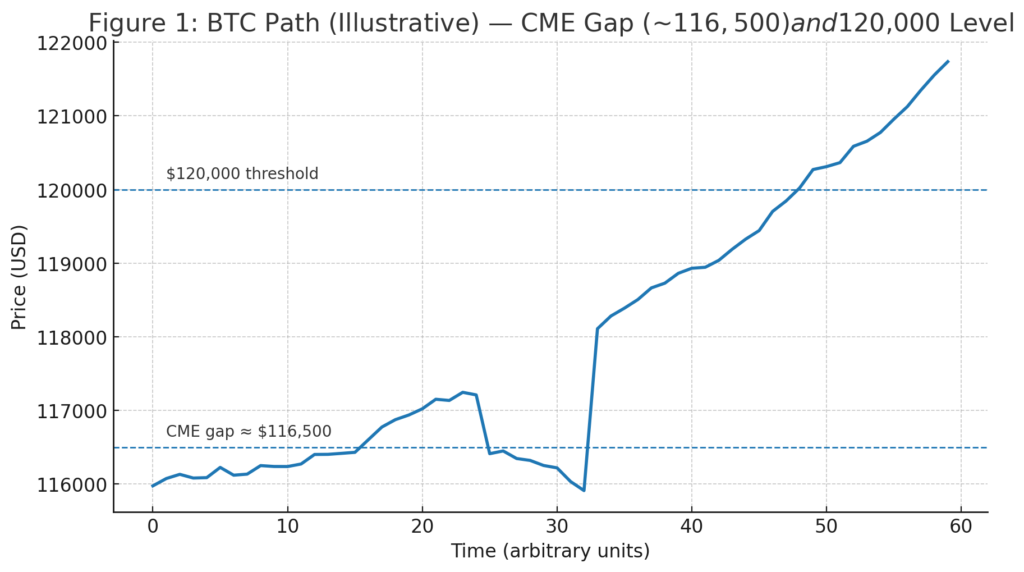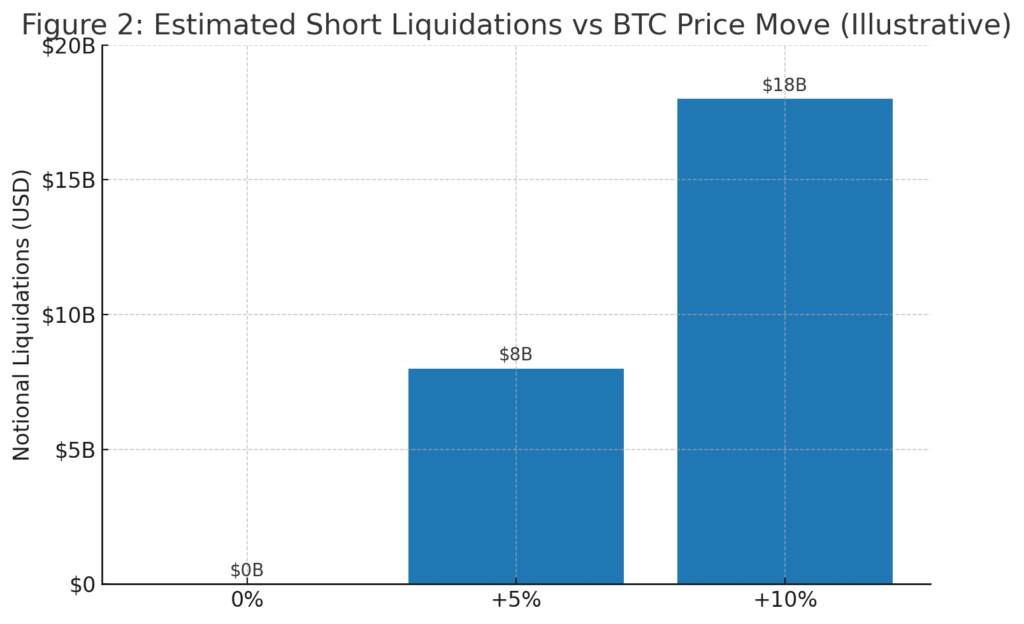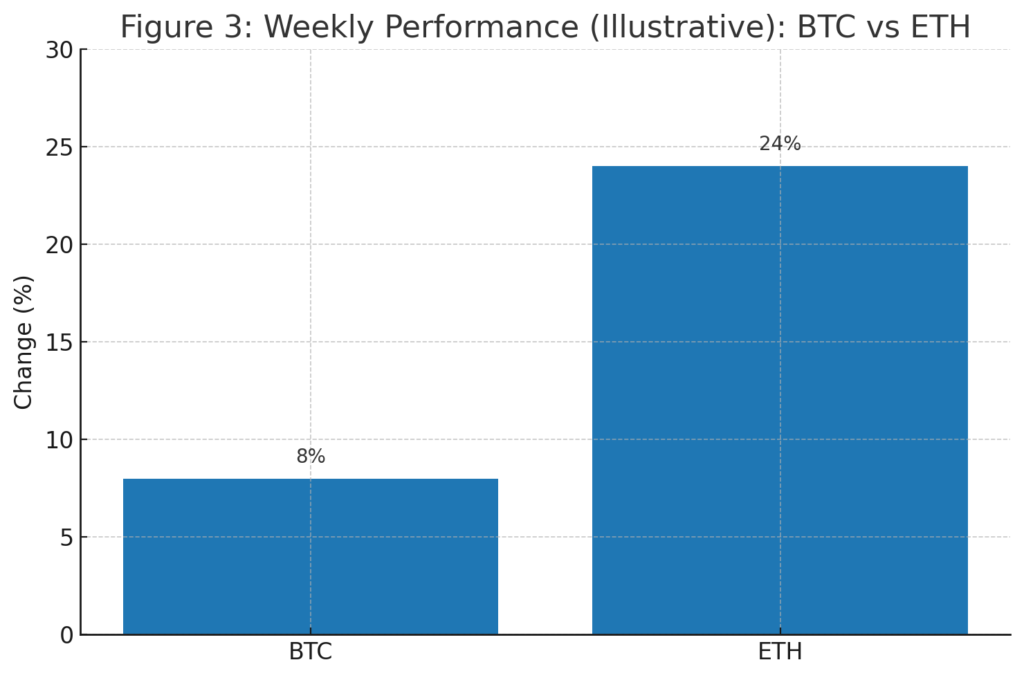
Main points :
- Bitcoin pressed toward $119,000 into a decisive weekly close, stoking expectations for a short squeeze that could liquidate roughly $18 billion of short positions if price jumps by 10%.
- Analysts are watching a CME futures “gap” around $116,500 as a likely magnet for near-term retracements before any new rally legs.
- Over the weekend, crypto markets already saw ~$350 million in liquidations, highlighting fragile positioning as volatility returns.
- Ether (ETH) climbed to multi-year highs above $4,300, with some analysts eyeing ambitious upside targets and an approaching all-time high test, reinforcing a broader risk-on bid across majors.
- For builders and investors, the backdrop favors measured risk-taking: staggered entries around liquidity pockets (e.g., gap-fills), disciplined sizing, and attention to derivatives signals (funding, open interest, liquidation maps).
[Insert Figure 1 here — BTC path with CME gap at $116,500 and the $120,000 line]

1) Where Bitcoin Stands: A Weekend Push and a Market Poised for Squeeze
Into the new week, Bitcoin (BTC) pressed toward $119,000, a move that sharpened the market’s focus on whether thin weekend order books would give way to a higher-volume squeeze once traditional venues reopened. The setup: shorts clustered above price and a chorus of traders flagging that a modest 10% leg higher could detonate a large chunk of bearish leverage. One widely cited estimate places potential short liquidations near $18 billion if BTC extends higher by that magnitude—enough to create a self-reinforcing rally as risk managers scramble.
Liquidation data over the weekend—roughly $350 million across crypto in 24 hours—suggests positioning remains sensitive, with one-sided bets vulnerable when liquidity is patchy. This is not a verdict on direction, but a reminder: when a market is crowded, small nudges can trigger large, mechanical flows.
2) The CME Gap at $116,500: Why This Level Keeps Coming Up
A recurring thread in trader commentary is the CME Bitcoin futures gap—in this case, a price void near $116,500 left between a Friday close and a subsequent Monday open. These gaps do not have mystical properties, but historically, BTC often revisits them, especially in choppy, mean-reverting stretches. That does not guarantee a fill, yet it does create a tactical waypoint many short-term participants plan around.
Why it matters: If BTC briefly dips into ~$116.5K, fills the gap, and buyers step in, the market can reset positioning and build a sturdier base for a higher-quality breakout. If price skips the gap and blasts straight through $120K–$123K, shorts above those levels may become the accelerant for the next impulse. Either path has tradeable implications, but the risk profile differs: buying into a gap-fill carries timing risk; chasing a runaway breakout carries momentum and slippage risk.
[Insert Figure 2 here — Estimated short liquidations vs BTC move]

3) ETH Strength Adds Fuel: Multi-Year Highs and an ATH Countdown
In parallel, Ether (ETH) printed multi-year highs above $4,300, with analysts discussing scenarios that include a near-term break of the former all-time high and—on longer horizons—targets well above, contingent on macro and liquidity dynamics. The immediate takeaway is simpler: ETH strength confirms a broader risk-on impulse, which historically supports higher beta across majors and select alt sectors when capital rotates beyond BTC.
This matters for BTC because cross-asset leadership can amplify flows. When ETH rips, ETH/BTC tends to rise, risk appetite expands, and some systematic strategies lean pro-crypto across the board. When ETH cools at resistance (recent data also highlighted intense sell-pressure episodes), that cross-tailwind can fade just as quickly—another reminder to synchronize BTC tactics with ETH inflection zones.
[Insert Figure 3 here — Weekly percentage performance: BTC vs ETH]

4) How a 10% Jump Turns Mechanical: From Shorts to Slippage
The logic behind the “10% jump = heavy short liquidations” claim is straightforward:
- Short interest has clustered above current price in pockets where stop-losses and margin thresholds overlap.
- A fast move through those pockets forces forced buying (short covers) on thin liquidity, creating slippage.
- Slippage hits not only shorts but also late longs, potentially producing a “blow-off” or “air-pocket” if fuel runs out.
Estimates for the aggregate notional at risk vary across trackers and timeframes; the headline $18B figure is an upper-bound scenario circulated by traders monitoring depth and positioning, not a guarantee. Use it as a scale reference rather than a singular target.
For verification, always triangulate with liquidation dashboards (e.g., heatmaps, cumulative liquidation levels by price) and open interest distribution across major venues. These tools help you quantify where pain likely concentrates and how sensitive the book is to small shocks.
5) Tactics for Builders, Funds, and Active Traders
A) Staggered entry near liquidity pockets
If you’re adding BTC exposure, consider layered bids around gap zones or prior consolidation shelves, acknowledging the risk of “no-fill” if momentum never looks back. Conversely, avoid single-price concentration that turns a tactical dip into portfolio drawdown.
B) Respect breakout dynamics
For breakout traders, define clear invalidation. Momentum can be explosive if $120K–$123K gives way, but failed breakouts in highly levered markets can unwind fast. Acknowledge your slippage risk in either direction by adjusting size.
C) Watch the rotations
ETH leadership has historically catalyzed alt-risk. If ETH sustains above key thresholds and BTC reclaims highs, sector rotations into ETH-beta (L2s, staking, infra plays) can follow. Yet if ETH hits supply and stalls, that tailwind can reverse just as abruptly.
D) Derivatives hygiene
Funding rates, basis, and open interest composition matter. Extended, one-sided positioning sets markets up for mechanical squeezes. Keep dashboards open and reduce exposure creep when signals flash hot.
6) What Could Derail the Bull Case?
- Gap fill becomes the trend: If the market repeatedly sells into gap-fills without strong demand, the path of least resistance can drift lower while derivatives bleed longs via negative carry.
- Macro surprises: Data (labor, inflation) or policy pivots that alter real-yield expectations and USD liquidity can torque crypto risk quickly.
- Rotation exhaustion: If ETH’s drive to multi-year highs stalls at supply (recently flagged by large net sell-imbalances), the broader risk bid can cool right when BTC needs a handoff.
None of these are foregone conclusions, but they are risk controls you can pre-register into your plan.
7) A Note on CME Levels and Calendar Structure
CME futures structure often anchors traders’ intraday maps: gaps, expiry weeks, and quarter turns shape tactic windows for many desks. While gaps are not destiny, they do correlate with flow magnets where hedging and speculative activity bulk up. Watching CME quotes and basis around front contracts adds texture to spot-led narratives.
8) Practical Checklist (Next 1–2 Weeks)
- Levels: $116.5K (gap magnet), $119.5K–$123K (breakout band), prior highs thereafter.
- Derivatives: Funding, OI, liquidation ladders on major venues; beware crowded one-way bets.
- ETH lens: Track ETH at multi-year highs; strength can lubricate broader crypto risk.
- Execution: Use staggered orders, preset invalidation, limit slippage by sizing for volatility, not for hope.
- Comms: If you operate products or treasuries, align messaging with volatility-aware roadmaps—clients and users appreciate predictability in unstable tapes.
9) Bottom Line
Bitcoin’s march toward $120,000 has the hallmarks of a market primed for position-driven acceleration. A mere 10% extension could, by some trader estimates, wipe out roughly $18B of shorts and push price discovery higher, while a quick gap-fill to around $116.5K could reset the spring for a sturdier breakout attempt. ETH’s surge to multi-year highs adds a supportive macro-crypto tone—provided it doesn’t stall at distribution zones. In this environment, disciplined tactics beat bravado: trade the flows you can measure, not just the targets you can imagine.

